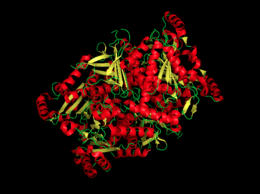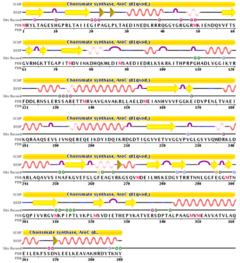General Information

Figure 1. A cartoon image of chorismate synthase.
Scientific Name: Aquifex aeolicus [1]
Genus: Aquifex [1]
Gene: Aroc [1]
Formula weight: 43494.9 Da [1]
Classification: Lyase [1]
Length: 388 residues [1]
Isoelectric point: 5.5 [1]
Chains: A,B,C,D [1]
Contagious diseases are increasingly becoming a major public health issue. The shikimate pathway is often used for the advancement of antimicrobial mixures to fight against these diseases. This process only takes place in prokaryotes, fungi and plants [2]. Chorismate synthase is the enzyme that is used in the shikimate pathway, which catalyzes the coversion of phosphoenol pyruvate to chorismate. Chorismate Synthase is an enzyme part of the lyase family. Choirsmate is used as a precursor to make the following proteins: L-tyrosine, L-phenylalanine, and L-tryptophan. Studying this enzyme and the roles that it plays in many diseases, inhibition of this reaction can lead to oral treatment for infectious diseases and further growth. This enzyme is responsible for catalyzing the following reversible reaction:
5-enolpyruvylshikimate-3-phosphate <--> Chorismate + Phosphate [3].
Structural Content
Chorismate synthase is a homo 4-mer structure, which is composed of four identical monomer subunits. The tetramer crystal structure of chorismate synthase was solved at 2.0 Å using the multiwavelength anomalous dispersion (MAD) method. Each monomer within the structure has a β-α-β fold motif[4]. One of the four monomers differs in structure slight close to the active site. This difference makes the active site a lot more accessible, making this monomer an “open” conformation. The monomer structure is composed of 35% (17 helices) and 18% (21 strands).

Figure 2. This image is representative of the sequence of chorismate synthase.
All of the beta sheets within each monomer run anti-parallel with one another. Helices are divided into two categories: alpha helices and 3/10 helices. In the structure there are eleven alpha helices and
there are six 3/10 helices. The image to the right displays the sequence of chorismate synthase. We can examine the two structures, chorismate synthase and with mycobacterium tuberculosis and FMN bound. The are both present within each monomer and goes from blue to red.
Mechanism
Below is the proposed mechanism for the enzyme chorismate synthase. Since chorismate synthase is part of the lyase family, there will be an elimination reaction with a newly formed double bond. A very important cofactor is needed, Flavin Mononucleotide (FMN), when it is reduced the reaction is able to take place [5]. The predicted model is that protonates the monoanionic reduced FMN and then protonates the leaving inorganic phosphate group of the substrate [6]. This is consider to be the , where all of the catalytic events partake. Based on current studies, FMN comes in and is protonated immediately by HIS 106 making FMNH2 and leaving. His 17 then protonates the leaving phosphate group to allow for the elimination to be completed [7]. To finish off the reaction, the electrons are shifted around to make a double bond that is necessary for the synthesis of aromatic amino acids. The aromatic amino acids that are form are tyrosine, tyrptophan, and phenylalanine; because of the double bond being formed within the six-membered ring.

Figure 3. The main mechanism of chorismate synthase involving HIS 17.
If we examine the image above we can see that FMN gets reduced and the phosphate group that is on carbon number 3 within the cyclic structure is removed and replaced by a double bond between carbon 2 and 3.

This is a representation of the two essential amino acids sites, HIS 17 and HIS 106.
The image to the left shows the two essential amino acid sites that are necessary for the conversion of 5-enolpyruvylshikimate-3-phosphate into chorismate [8]. It is required that the two active site be within 3Å in distance for the reaction to take place. This is why we know that HIS 106 is required for the reaction but not sure as to what role it plays exactly.
Inhibition
Chorismate synthase can be inhibited by many molecules which is effective for antimicrobial drugs because this process only takes place in microorganisms and plants. One common inhibition is through (6R)-6-Fluoro-5-enolpyruvylshikimate-3-phosphate [9]. This molecule is able to convert 5-enolpyruvylshikimate-3-phosphate into chorismate but stays attached to chorismate preventing any functionality[10].
Implications
Enzymes present in the shikimate pathway are important in microorganism survival. The enzymes of the shikimate pathway are a great source for antimicrobial agents, herbicides, inhibitors and drugs. The implications with studying choristmate synthase revolves around the fact that it isn not present in humans but is essential for bacteria, plants and parasites. This pathway gives rise to many potential antimicrobial drugs which decreases possible negative impacts of drugs in humans [11]. One major disease is mycobacterium tuberculosis, that can be stopped using chemotherapy due to the use of inhibitors that can prevent chorismate to be produced and effect the human body.




